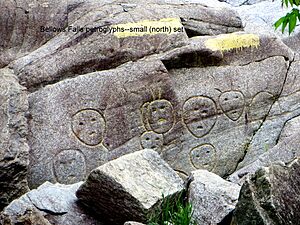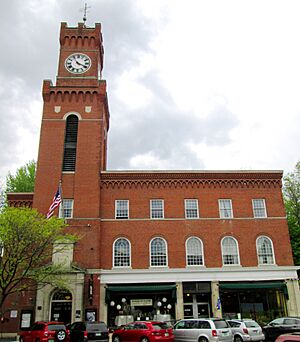Bellows Falls, Vermont facts for kids
Quick facts for kids
Bellows Falls, Vermont
|
|
|---|---|
|
Village
|
|

Bellows Falls in the early spring,
viewed from Fall Mountain in New Hampshire |
|
| Country | United States |
| State | Vermont |
| County | Windham |
| Incorporated | 1909 |
| Area | |
| • Total | 1.39 sq mi (3.59 km2) |
| • Land | 1.37 sq mi (3.55 km2) |
| • Water | 0.02 sq mi (0.05 km2) |
| Elevation | 312 ft (95 m) |
| Population
(2020)
|
|
| • Total | 2,747 |
| • Density | 2,005.1/sq mi (774.2/km2) |
| Time zone | UTC-5 (Eastern (EST)) |
| • Summer (DST) | UTC-4 (EDT) |
| ZIP code |
05101
|
| Area code(s) | 802 |
| FIPS code | 50-04225 |
| GNIS feature ID | 1456381 |
Bellows Falls is a small village in Vermont, United States. It's part of the town of Rockingham in Windham County. In 2020, about 2,747 people lived there. Bellows Falls is known for the Green Mountain Railroad, which is a special train line that keeps old trains running for fun. It also hosts cool events like the Roots on the River Festival and the No Film Film Festival.
Contents
History of Bellows Falls
The area where Bellows Falls is located was first settled by English colonists in 1753. They called it Great Falls because of the large waterfall on the Connecticut River. Later, the town was named after Colonel Benjamin Bellows, a local landowner. However, the waterfall kept its original name, "Great Falls," which came from the Abenaki name "Kitchee pontegu."
In 1785, Colonel Enoch Hale built the very first bridge over the Connecticut River right here. For many years, it was the only bridge across the river! Today, two bridges connect Bellows Falls to New Hampshire: the New Arch Bridge (built in 1982) and the Vilas Bridge.
The Bellows Falls Canal
One of the oldest canals in the United States, the Bellows Falls Canal, was built between 1791 and 1802. A canal is like a man-made river that helps boats travel around difficult parts of a natural river. This canal was dug to help ships get around the Great Falls waterfall. It had nine locks, which are special sections that lift or lower boats to different water levels.
Over time, the canal's use changed. After railroads became popular in 1849, fewer boats used the river. So, by 1858, the canal was mainly used to power local paper mills. The water from the canal turned machines in the mills.
The canal was made wider and deeper over the years. In the early 1900s, it started being used to generate electricity instead of just powering mills directly. Today, the canal is part of the Bellows Falls Downtown Historic District. It even has a special fish ladder that helps salmon swim upstream past the falls!
Growth of Industry and Tourism
In 1802, the first paper mill in Windham County opened in Bellows Falls. When two railroad lines arrived in 1849, the village grew into a busy mill town. Factories produced many things, including textiles, furniture, iron, and even organs.
Because of all this industry, the town became quite wealthy. Many beautiful Victorian houses and shops were built. Today, Bellows Falls is a popular place for heritage tourism. This means people visit to see the historic buildings and learn about the town's past. The old town center, the canal, and many homes are now protected as historic districts because of their importance.
Geography and Population
Bellows Falls is located in the town of Rockingham. It covers about 1.4 square miles of land. The Connecticut River forms its eastern border.
| Historical population | |||
|---|---|---|---|
| Census | Pop. | %± | |
| 1870 | 697 | — | |
| 1880 | 2,229 | 219.8% | |
| 1890 | 3,092 | 38.7% | |
| 1900 | 4,337 | 40.3% | |
| 1910 | 4,883 | 12.6% | |
| 1920 | 4,860 | −0.5% | |
| 1930 | 3,930 | −19.1% | |
| 1940 | 4,236 | 7.8% | |
| 1950 | 3,881 | −8.4% | |
| 1960 | 3,831 | −1.3% | |
| 1970 | 3,505 | −8.5% | |
| 1980 | 3,456 | −1.4% | |
| 1990 | 3,313 | −4.1% | |
| 2000 | 3,165 | −4.5% | |
| 2010 | 3,148 | −0.5% | |
| 2020 | 2,747 | −12.7% | |
| U.S. Decennial Census | |||


Population Information
According to the census from 2000, there were 3,165 people living in Bellows Falls. There were about 1,329 households. The population was spread out, with many young people and also a good number of older adults. The median age was 37 years old.
Things to See and Do
One of the most interesting cultural spots in Bellows Falls is the Bellows Falls Petroglyph Site. These are ancient rock carvings, called petroglyphs, found on large boulders near the bridge. They offer a glimpse into the history of the people who lived here long ago.
Transportation
Bellows Falls has a historic railroad station that was once a very busy hub for trains.
Famous People from Bellows Falls
Many interesting people have come from Bellows Falls, including:
- Colleen Barrett — A former president of Southwest Airlines.
- Carlton Fisk — A famous American baseball player.
- Hetty Green — A very successful American businesswoman.
- Thomas P. Salmon — A former Governor of Vermont.
- Ernest Thompson — An American writer, actor, and director.
- Rick Veitch — An American comics artist and writer.
See also
 In Spanish: Bellows Falls para niños
In Spanish: Bellows Falls para niños


